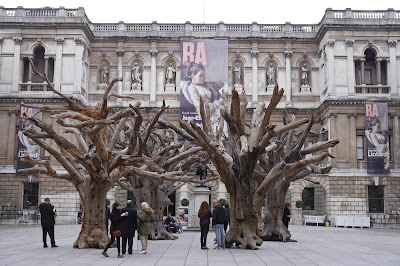Eros
I picked this walk around Mayfair from the excellent London's Hidden Walks (vol 1) by Stephen Millar; it starts from Piccadilly Circus. Naturally, my first picture was of Eros, but how many people know that it commemorates the 7th Earl of Shaftesbury, the great Victorian philanthropist. Eros was the son of Aphrodite and god of love in Greek mythology, so what is the link? The sculptor intended the statue to represent Anteros (Eros's twin brother, god of unrequited love - it's no clearer why this was thought appropriate), but others have claimed it represents the Angel of Christian Charity. Nowadays, no-one seems too worried by any of this.
Just along Piccadilly there is St James's church by Wren, strangely not mentioned in the walk description. A mouthwatering food market was in full swing.
Further along on the left is The Albany, an 18th century house which was converted in 1802 into bachelor apartments. Edward Heath lived there.
Set back from the road in a similar way is Burlington House, home of the Royal Academy of Arts. In the courtyard is the well-named Tree by Ai Weiwei (part of his exhibition which has just closed). Ai’s trees are made from parts of dead trees from the mountains of southern China. They are curiously affecting.
On the other side of the road is Fortnum & Mason whose famous clock dates only from 1964. When the clock strikes the hour the figures of Mr Fortnum and Mr Mason emerge from the two boxes.
Now for Burlington Arcade, also not mentioned in the walk description, opened in 1819.
A right turn brings you into Albemarle St where 45-6 is an influential modernist building of 1957 by the Hungarian architect, Ernö Goldfinger. I can't say I like it. Perhaps this is why Goldfinger's name was borrowed by Ian Fleming for one of his Bond villains.
Also in Albemarle St is the Royal Arcade of 1879. It and the Burlington Arcade are certainly as impressive as the Paris arcades we saw on a walk there in 2010.
The route now meanders through Dover St, Hay Hill and Curzon St, passing through the charming Shepherd Market to return to Curzon St and head left up Chesterfield Gardens. Many places highlighted in the description are where famous people lived or died. I can't usually summon much enthusiasm for this, but I was struck by 4 Chesterfield St which had accommodated both Beau Brummel and Sir Anthony Eden.
The route continues to the lifeless Berkeley Square and then into Mount Street, which is home to a number of impressive red brick and terracotta buildings.
The pretty Mount Street Gardens leads to the Church of the Immaculate Conception, a catholic church of 1849 with an elaborate altar by AWN Pugin.
You emerge from the gardens into South Audley Street and the Grosvenor Chapel build in 1730 for the Grosvenor Estate, which continues to own much of the land in this area
South Audley Street leads into Grosvenor Square, the second largest in London after Trafalgar Square. It is dominated by the American embassy on the west side. There is a nice statue of Franklin D Roosevelt on the north side
You leave the square from the north east corner and walk up Duke St to find the delightful Brown Hart Gardens. They were laid out in 1903 above an electricity sub-station, but closed from the mid 1980s to 2007. The decking reminded me of the High Line linear park in New York.
Opposite is the Ukranian Catholic Cathedral of the Holy Family in Exile. It was designed by Alfred Waterhouse and was previously a Congregational church.
The walk continues back to Piccadilly Circus, but I left it here.
Conditions: pretty grey.
Distance: About 2.5 miles.
Rating: three stars. Interesting enough, but no real stand-out sights. I did not find myself in sympathy with Mayfair's aura of wealth and privililege.















No comments:
Post a Comment